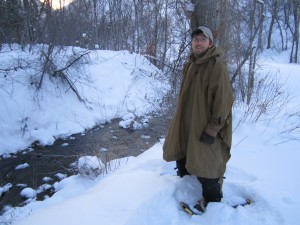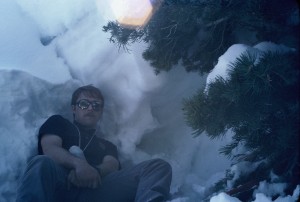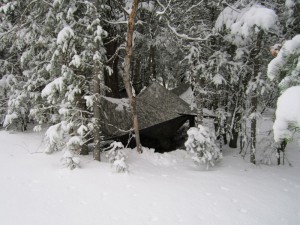Winter Trip with no Tent, Fire or Stove
On a winter night in late January, I lay in my homemade sleeping bag, the temperature nearing -40°F, the stars seemed exceptionally bright, until the full moon showed up, and it was almost too blinding to look at in the crystal clear night sky. I was sleeping in my favorite way for winter camping, on the snow with no tent, no roof over my head. My protection from the wind when it arose was a piece of 6 mil clear plastic about 8’ x 8’ which I had folded in half lengthwise and sealed the bottom and one side with an iron to make a tube with a closed bottom end. When the wind wasn’t bad I would often slide out the top a bit to gaze around.
One time I used the above set up along with mukluks, a coat, mittens, a hat and insulated pants all of which I made myself, on a trek into the Uintah Mountains in the winter just a week after four feet of new snow fell. I went for almost a week and never lit a fire and did not ever use a stove. I waded through streams that were still running, fell in once. Never used a tent, an igloo or snow cave. My clothing was so well insulated that many times I would stand in my snowshoes throw off my backpack and just fall back into the snow and sleep for a few hours.
Freest style of camping there is
One of the nice things about camping like that, is you never have to make camp, camp is you. When it was bright at night I often snow shoed through much of the night. Whenever I needed a rest I would just take one. No tent to set up, no fire to make, no stove to run. It is the freest style of camping there is.
The main concept was that my clothing was my shelter most of the time, I used the sleeping bag system only when I planned to sleep for 8 hours or so. The thing I was looking to do was emulate the animals, the deer and the elk, to be able to just be out in the weather and be fine with nothing else. I see so many people out these days frightfully unprepared. They ride the snow machine or ATV, with little protective clothing and they are OK unless they get stuck or break down, but hey, when does that ever happen?
We are coming into fall and winter now. Already snows have fallen and are still there in the mountains. Whatever you do for shelter, remember that clothing is part of your shelter and can even be all your shelter if you want it to be so. Much of the time we coop ourselves up in tents or caves or igloos when in reality we don’t need all that. These days normally the closest I come to a tent is a tarp set up. Don’t get me wrong it is a lot of fun constructing various shelters and using them, getting really cozy and all, but I find it fun also to go the other way around and be in the open as much as possible.
Shelter is likely in the short term the most important element of survival. Everyone talks like crazy about fire, mostly because it’s the most fun thing to do. Lack of shelter can kill a person faster than any of the other elements, as fast as a few minutes in some cases. Don’t scrimp or shortchange yourself on shelter. You don’t need to spend a ton of money, just be sure what you have protects you. We’ll talk in more detail about it in upcoming blogs as the season progresses.
Here’s a short list of tips for shelter
- Footwear – insulated well, breathable if below 20°F, waterproof if warmer
- Headwear – covers the head well, wind resistant, over ears and the neck
- Mittens – if you really want warm hands ditch the gloves and use mittens
- Legwear – long underwear or insulated pants. Make sure there is breathability, especially if snowshoeing. Legs that zip open can be nice for when it gets too warm
- Corewear – a coat of some sort to protect your body furnace, the core. Able to seal around neck to retain rising heat when it is really cold
- A tarp like our PST can be nice to give a roof or quick wall if needed, can be a ground cloth too, or a door. If things get really rough combine with an emergency blanket to make a really warm Super Shelter
- A poncho like our PSS is great as it can double as a tarp, or it can be worn to keep wind from driving through you. You can make a one person Super Shelter with it as well
So start thinking about the colder weather ahead and plan out the gear you need to be safe. Practice with variations of gear set ups before embarking on any major trip.
Until next time this is Perry Peacock, “Simplifying Survival”




Were these clothing items the Jim Phillips foam gear?
What thickness of foam, what type cloth for inner liner and what for outer shell?
You made them – – what pattern or what *how-to* instructions for others?
Did you ever put up the *howto* video on muk luks?
Thanks in advanc.
Lewis, They were patterned originally from Jim’s father Gill. The foam was 1″ thick, shell nylon or polyester, liner nylon. I made them using a pajama pattern which I modified a bit…I am recording a new mukluk video for this season. Thanks for following us and for your comment.
Thanks once again Brother Peacock for all of the new equipment
I know a lot of people who would purchase supplies to make their own clothing if you carried them. They report all kinds of trouble getting foam clothing supplies from other experts. My homemade gear is awesome and was borrowed for the last 2 years for Iditerod and some other runs by a musher who has metabolic issues (diabetic)…likes better than Northern Outfitters…..I do not have time to sell anything, focusing on nursing and medicine during days of survival…If there is anything you could do to make the stuff available I would be more than glad to help you with any specific fabric engineering if you do not already know or have contacts.
I have a handle on all of the engineering of this clothing and what companies manufacture what is needed. The inner liner JP is using is fabric I found for them as the Versatech USA fabric was too expensive and too difficult to purchase in quantities needed for a small company. I am well aware of the specs for the good foam and who manufactures this.
I even know of some pretty good patterns that can be enhanced to make really high end good looking and well serviced stuff….
I helped John Arbon a little in his design of his excellent foam bag his company manufactures.
I use a modular foam sleeping bag tested in Nome, Alaska by my nephew and others. My pod is different than what he uses and is designed for longer term survival over many months and changing conditions.
JP also uses a second outer coat that some are not aware of when out for some time…this is because over time when out in the extremes, the primary foam clothes and outer shells are not enough as our changing nutrient loads and constant extreme weather conditions gradually impact safety.
Hey…edit this or take this off line will you? Im not out to bash or put down anyone who is trying to help others get prepared…just presenting some facts as i know it.
I have found your single sheet foam blanket to be the best investment for car kits there is….super idea
Did dr prepper interview you on the radio blog preparedness network yet?
Kathleen
You undoubtedly help it become seem to be not thay hard with all your display on the other hand locate this specific subject matter to get essentially the one thing i feel I’d by no means have an understanding of. Seems like far too challenging and extremely huge in my opinion. We are looking ahead of time for your upcoming post, I’ll attempt to learn this!
I am looking for the survival blanket system what are the layers called ?
Jason, We have upgraded our blanket system since this post. The system is called Osni Gear. This is warmer, more compressible, and considerably lighter, while still performing in the same manner. Osni gear has double sided snaps to allow stacking or layering blankets or poncho liners, so you can customize based on your conditions. If I’m on the ground for sleeping I like to use our Beast sleeping pad as it has a snap system that matches our Osni Gear and our ponchos as well. You can build your shelter according to your needs. – Perry